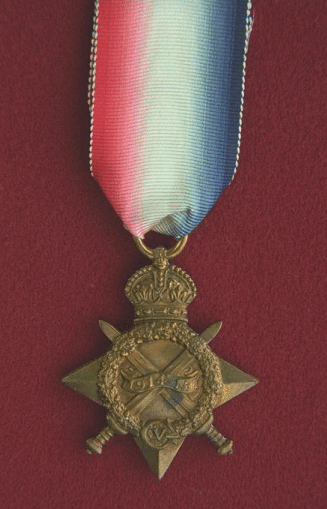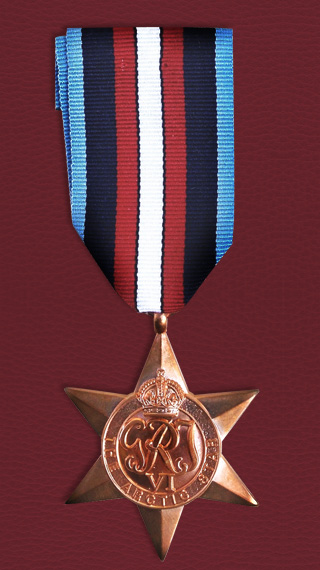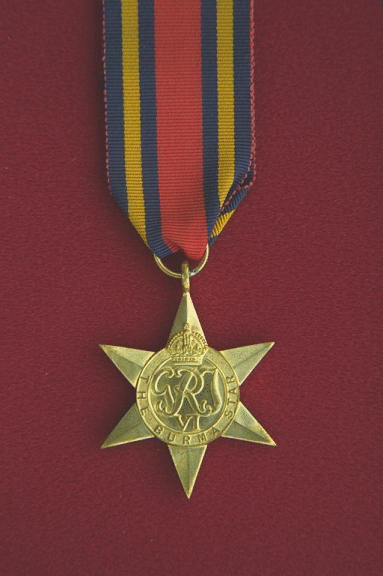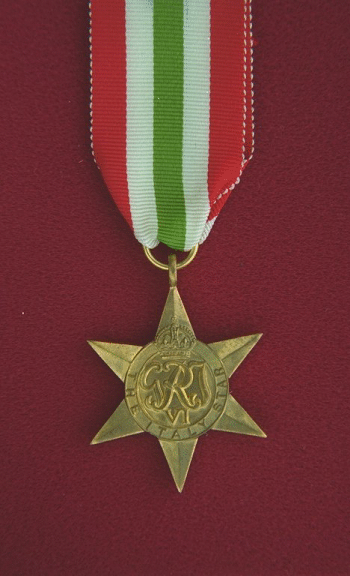How to recognize the campaign stars and medals Canadian troops earned during The Great War, World War 2, and the Korean War.

I wasn’t able to attend the D-Day commemoration ceremonies at the Military Museums yesterday morning, however, I was able to stop in at my new home Legion Branch #285 (Calgary Centennial) later on to grab a bite and a beer at around one o’clock. Just as I reached the front door, branch president Kent Griffiths was about to walk out with George Morash, helping the veteran and fellow Calgary Highlander to his car. I held the door open for them, thanking the World War Two veteran for his service as he passed me.
By that time the majority of the senior-most of the “Old Guard” had left the building or were about to depart shortly and I recalled similar occasions from long ago when the oldest of the Old Guard were the veterans of 1914-18. That generation is gone now, and it won’t be long before the WWII generation joins them in the pages of history. It was strange not to see any of the Great War vets and it will seem stranger still to me to no longer see any vets from 1939-1945. Every year they get fewer and fewer, and so do our opportunities to honor and thank them for the sacrifices that they had made in their younger days.
Service Medals and Campaign Stars.
Pretty much universally military medals and decorations fall into one of three categories:
- Service Medals – Typically these indicate participation in a specific conflict during a specified time and tend to be widely distributed among troops.
- Campaign Stars – Indicate participation in areas within an active combat area, in the presence of an armed enemy.
- Awards for bravery or distinguished service – for example the Victoria Cross or DSO.
Only the first two will be covered here.
1914-18 The War to End All Wars.
In February 2010, the last known Canadian World War One Veteran, John Babcock, passed away at his home in Spokane, Washington. Nevermore would these decorations be seen on the chest of a veteran who had earned them.
1914-1915 Star

British War Medal

The requirements for Royal Air Force (RAF) personnel were the same as for the Army. Naval personnel were required to have 28 days of mobilized service or to have lost their lives before this period of service was complete. Seamen of the Canadian Merchant Marine who served at sea not less than six months, and crews of Dominion Government Ships and the Canadian Mercantile Marine were also eligible.
Victory Medal (Inter-Allied War Medal)


World War 2 – The Greatest Generation.
There were 13 service medals and campaign stars available to be awarded to Canadian soldiers, sailors, and airmen during WW2 in numerous colours and patterns. These troops were not limited to being awarded only these decorations however, as several were often decorated with honours from other countries such as the French Legion of Honor, so if you happen to see a medal being worn by someone that isn’t listed here, that is the reason why that is.
My maternal grandmother had five brothers who fought in Europe, all came home physically intact. Uncle Johnny, Uncle Tommy, Uncle Alfred, Uncle Bill, and Uncle Donald all volunteered although I can only ever remember seeing Uncle Bill and Uncle Donald wearing their medals on their respective blazers. They told some stories about the war, but by and large, it was something they didn’t really talk about much.
1939-1945 Star

Atlantic Star

Issued between 03 September 1939 and 08 May 1945 (Europe) or 02 September 1945 (Pacific). The Atlantic Star was awarded for six months of service afloat or two months for air-crew service and was not awarded unless the recipient was qualified for the 1939-1945 Star by six months of operational service afloat or by two months of airborne service. Therefore, the total requirement was twelve months of service afloat or four months of airborne service.
Air Crew Europe Star

Arctic Star

Eligibility is defined as follows:
Navy and Merchant Navy – Eligibility for Naval and Merchant Navy service anywhere at sea north of the Arctic Circle is to include, but is not limited exclusively to, those ships participating in, and in support of, convoys to North Russia.
Air Force – Aircrew of the Royal Canadian Air Force will be eligible if they landed north of the Arctic Circle or served in the air over this area. Non-aircrew on operational service in the area are also eligible.
Army – Army personnel serving in His Majesty’s Canadian ships or in defensively equipped Merchant ships qualify under the rules applying to the Navy or Merchant Navy. In addition, personnel taking part in land operations north of the Arctic Circle will also be eligible.
General – Service on the Greenland Sea outside of the coastal limit, Norwegian Sea and Barents Sea within the Arctic Circle are areas of service for eligibility to this star.
General – Eligibility to the Arctic Star has no effect upon eligibility for Second World War recognition previously awarded and does not suggest automatic eligibility for any further awards.
Africa Star

Eighth Army: Awarded for service with that army between 23 October 1942 and 12 May 1943. An ‘8’ is worn on the ribbon in undress to denote this bar.
North Africa 1942-1943: Awarded for service with the Navy, Merchant Navy, Air Force or headquarters of the 18th Army Group between 23 October 1942 and 12 May 1943. In undress, a rosette on the ribbon denotes this bar.
Only one bar is worn and when the ribbon is worn alone a ribbon emblem, ‘8’, ‘1’ or silver rosette as appropriate is worn to denote the award of a bar.
Pacific Star

Navy and Merchant Navy personnel are eligible if the 1939-45 Star is earned by six months service or if they entered the Pacific Theatre between 2 March 1945 and 2 September 1945.
Burma Star

Navy – six months qualifying service for 1939-1945 Star first, then operational service in the Bay of Bengal and in the Malacca Strait;
Army – service on land in Bengal and Assam from 1 May 1942 to 31 December 1943, areas of Bengal and Assam east of the Brahmaputra from 1 January 1944 to 2 September 1945 and operational service in China and Malaya from 16 February 1942 to 2 September 1945; and
Air Force – one operational sortie for aircrew and qualifying service as for Army for other Air Force personnel.
France and Germany Star

Italy Star

Defence Medal

Under the terms of this last condition, Canadians serving for one year in Newfoundland were eligible and persons serving for six months in Hong Kong were also eligible. The qualifying period in mine and bomb disposal was three months. Canadians serving in West Africa, Palestine and India, other than operational air crew, qualified for this medal. Those awarded the George Cross (GC) or George Medal (GM) for civil defence received this medal. Home Guard and others in Britain qualified for this medal.
Canadian Volunteer Service Medal

Newfoundland Volunteer Service Medal

who volunteered and served in units or organizations raised or maintained as the contribution of the Dominion of Newfoundland to the allied war effort, namely, the British Imperial Forces, the Newfoundland Overseas Forestry Unit, the Merchant Navy and the Newfoundland Regiment, or, a unit or organization prescribed by the Lieutenant Governor in Council; and
who is ineligible for or has not received a volunteer war service medal from another country.
War Medal 1939-1945

Bars
Hong Kong Bar

Bomber Command Bar

Recognizing that the successes of Bomber Command started on the ground and finished in the air over Fortress Europe, all Canadian Bomber Command Veterans who earned the Canadian Volunteer Service Medal (CVSM), regardless of rank or role, are eligible for the honour.
Dieppe Bar

A silver bar, to be attached to the ribbon of the Canadian Volunteer Service Medal (CVSM), has been designed featuring the word DIEPPE in raised letters on a pebbled background. Above this, the bar bears an anchor surmounted by an eagle and a Thompson sub-machine gun. The design was created in consultation with the Dieppe Veterans and Prisoners of War Association.
The Korean War.
Sitting at an empty table, I ordered a bottle of Pilsener beer and a plate of grilled perogies with sour cream, onions, and bacon bits for lunch. A couple of tables away sat a Korean War veteran, enjoying a cold beer with his son. I would come to find out that his name was Sam and before I left I wanted to pay him a visit. I told him that I had an uncle who had fought in Korea and he told me that he served in the Navy during the war. I thanked him for his service, and he said he didn’t think many people would even recognize his medals, but I did. He gave me a firm handshake, and I told him I wanted to buy him that beer he was drinking. His son had just paid the bill, but I left him some money to cover his next one and told Sam that he had already paid for that beer a long time ago.
Korea – First Conflict of The Cold War and to see UN Participation.
It was in the Korean War that troops from the United Nations would make their premiere appearance, and they would do things slightly different than before. Whenever they were deployed, UN troops were seen to be on a “mission” as opposed to being on “campaign”, thusly there were no United Nations “Campaign Stars” awarded despite troops potentially being engaged in a hot-shooting war scenario. Instead they were considered “service medals”.
Canadian Korea Medal

Canadian Volunteer Service Medal for Korea

was in the Canadian armed forces during all or part of the period from 27 June 1950 to 27 July 1954:
was in the qualifying area (defined as Korea and the adjacent areas, including Japan, Okinawa and Korean waters); and
during the period referred to in (a),was on the strength of an army unit or formation in Korea for at least one day;
was on active service for at least 28 days on a ship or craft engaged in operations in the qualifying area;
flew one sortie over Korea or over Korean waters in the Yellow Sea or East Sea (Sea of Japan), or:
accumulated at least 28 days service in the qualifying area.
United Nations Service Medal (Korea)

The United Nations Service Medal was instituted 12 December 1950 for service from 27 June 1950 to 27 July 1954 and was earned for serving one day under United Nations’ command in Korea or adjacent areas, including Japan and Okinawa. The medal could also be awarded for an aggregate of thirty days, which need not have been consecutive, spent on official visits of inspection to the qualifying area. The qualifying period was 27 June 1950 to 27 July 1954 (One year longer then in the case for the Canadian Medal for Korea).
Visit the VAC website for more information.
Photos and information used herein were provided by Veteran’s Affairs Canada. Visit the webpage linked below to find information about Canadian Honours and Decorations from Confederation to the present day.
https://www.veterans.gc.ca/en/remembrance/medals-decorations